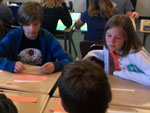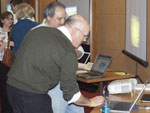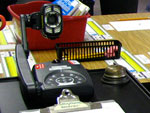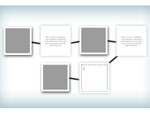Michael Yell Motivates Students with the Mystery Strategy

The word history comes from the Greek historein—meaning “to inquire.” Recommendations for using inquiry [for learning history] have a long tradition.
People learn through inquiry. . . . inquiry is an approach consistent with current theory and research on human learning. When understanding is needed, inquiry appears to be one of the best ways to get there.
–Keith C. Barton and Linda S. Levstik
Teaching History for the Common Good
As teachers of history and social studies teachers, I am convinced that we can regularly experience the motivating effects of having students ask questions, think, and interact while inquiring into historical events, issues, people, and ideas. To deeply involve our students in the study of history, inquiry is indeed the best way to get there. And posing historical questions as mysteries is an excellent way to involve the students in discovery.
Having our students get involved in the process of inquiry is not a matter of simply telling them “here is a problem, here are some sources, now go for it.” That approach will prove no more motivating to most than simply telling them to open their notebooks and then listen to a lecture. However, there are practice-proven strategies that are available to the teacher in order to thoughtfully engage their students in the inquiry process. Mystery, along with Discrepant Event Inquiry (explained in my previous blog), is a highly motivating strategy that will do just that.
Your students are in groups of four discussing topics about the colonization of what would become the United States, and you bring up the lost colony of Roanoke (perhaps in a Discrepant Event Inquiry). Students express an interest in the topic and begin to pose questions that they would like to answer about the colony. When the students next come into class, each group is given a manila envelope containing 12 strips of paper each with a Roanoke fact that they will put together as clues, discuss, and use as they hypothesize on what might have happened to the lost colony.
This strategy presents a mystery, but does not provide answers—rather students develop answers for themselves by analyzing clues. Using the strategy of mystery is not only sound in terms of student interaction and thinking—it is motivating and fun. Mystery combines cooperative learning with inquiry as small teams work together to share and analyze clues and develop tentative hypotheses, as the strategy presents the mystery to be solved, but not the answer. In using the mystery strategy you will find student’s curiosity is piqued, they are motivated and interact, and they are thinking and inquiring,
As with Discrepant Event Inquiry, students have been confronted with a puzzle, but in this case, they are also given historical evidence, in the form of clues. In working with these clues, students begin by organizing the clues according to similarities and common attributes, and developing a label for each category. It is then that the groups must begin to identify and explore relationships between the clues and go beyond them by making inferences as to how they fit together and what they mean. Finally they must develop tentative hypotheses that would explain the phenomena they are studying. Finally, the class discusses and evaluates the various hypotheses that have been developed.
Prior to beginning the strategy, peak student interest in something unknown or mysterious in the historical era that you are studying (such as the lost colony of Roanoke) and have them begin to develop the questions that they would like to try to answer.
There are three steps in the Mystery strategy:
- Prepare a set of clues for a mystery that will be given to each group (I develop about 12 clues and each group will receive the same set). Although the clues can take many forms (quotations, short primary source documents, pictures, charts or graphs), I begin by using short written clues that contain basic information about the topic in question. For example, the Roanoke mystery might contain clues such as “three years after John White left the Roanoke he returned to find it empty,” “there was no trace of the colonists,” “on a post was carved the word CROATOAN,” “there was a nearby tribe called the Powhatans,” “there was no sign left by the colonists that they had fled from danger,” etc. There must be enough clues to help students begin to formulate a number of hypotheses. The information can come from readings you have done, resources that you find via the Internet, from DVDs—even from the textbook
- Pass out a set of the clues to each group. The group members then distribute and share clues amongst themselves, organize the clues into groups by similarity, label the groups, compare them, and use the information to develop a hypothesis about the Mystery topic.
- You select a format for the presentation of student hypotheses. This can take the form of a class discussion and/or through written products. Whatever format you choose, students should share and defend their ideas and the class should engage in a synthesizing discussion.
Organizing information, making sense of data, and developing reasonable hypotheses and explanations based upon evidence are all essential components of inquiry, and all essential skills and habits of mind for our students.
To engage our students in this type of thinking, in this type of work, is not only more important than recall alone, it is more fun for them and for us as teachers. With such strategies as Discrepant Event Inquiry and Mystery we help our students develop questions and reason through information in attempting to answer those questions.
Using inquiry in the classroom does take some work, but it is good work. The journey from teaching history as a body of content to be memorized to teaching history as inquiry, as a way of thinking and questioning, is a powerful one. It is important for history teachers to incorporate primary sources into their lessons, not as an end in itself, but as a means to further students’ inquiry into eras, people, and ideas of the past. In my next blog, I will share one of the strategies I have found is excellent for the use of primary sources in the history classroom.
Barton, Keith C. and Linda S. Levstik. Teaching History for the Common Good. Routledge, 2004
Harvey F. Silver, et al. The Strategic Teacher: Selecting the Right Research-Based Strategy for Every Lesson. Alexandria: Association for Supervision and Curriculum Development, 2007.
For a complete description of both the Discrepant Event Inquiry and Mystery strategies, see Yell's article "Engaging World History Students in Inquiry: Using Our Thinking Factors” in an upcoming issue of Social Education.
For more on Discrepant Event Inquiry, another strategy that engages students with history mysteries, check out Yell’s blog entry "Developing a Climate of Engagement".
In the Teaching Guide "Mystery Strategy for Elementary Students," former elementary teacher Lisa Cooper explores a strategy for introducing younger students to history investigation.











 Some document cameras come with a freeze image button which is a great feature to capture a page in a book or map that might be difficult to hold in place. If the document camera does not have this feature, you can hook up the document camera directly to the video projector, which often has the ability to freeze an image. If your document camera is not one that hooks up to your computer via USB, you can also set up the document camera directly to your projector. This allows you to toggle between the image on your computer screen (assuming it too is attached to your video projector) and the image from your document camera. You can also connect most document cameras to a television using an S-video cable or component video cable. It should be noted, however, that the clarity is not as crisp when using the S-video cable or component video cable compared to using a VGA or DVI connection.
Some document cameras come with a freeze image button which is a great feature to capture a page in a book or map that might be difficult to hold in place. If the document camera does not have this feature, you can hook up the document camera directly to the video projector, which often has the ability to freeze an image. If your document camera is not one that hooks up to your computer via USB, you can also set up the document camera directly to your projector. This allows you to toggle between the image on your computer screen (assuming it too is attached to your video projector) and the image from your document camera. You can also connect most document cameras to a television using an S-video cable or component video cable. It should be noted, however, that the clarity is not as crisp when using the S-video cable or component video cable compared to using a VGA or DVI connection. 


![[Stereograph], library of congress [Stereograph], library of congress](/sites/default/files/ad08001r.jpg)
